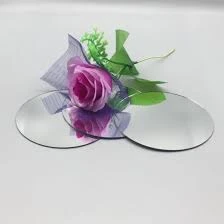

The Silver Mirror Reflection and Revelation
The silver mirror has long been a symbol of beauty, vanity, and even introspection. As a material, it has a storied history, steeped in both practical application and metaphorical significance. In the world of art, literature, and philosophy, the silver mirror often represents the duality of human nature — our outer appearances contrasted against the inner self. In exploring this duality, we open a window into the complexities of identity and perception.
In its most literal sense, a silver mirror is made by coating glass with a thin layer of metallic silver, a process that dates back to ancient times. The earliest mirrors were made from polished stones such as obsidian, bronze, or even water. However, the advent of silvered glass mirrors in the 16th century marked a significant turning point. These mirrors not only reflected light but also captured the imagination, becoming symbols of status and sophistication.
In literature, mirrors have been used as powerful metaphors. They reflect not just physical appearance but the deeper aspects of the soul. For instance, in Lewis Carroll's Through the Looking-Glass, the mirror serves as a portal to another world, where the rules of reality are turned upside down. This idea of the mirror as a gateway speaks to the transformative power of reflection — both literally and figuratively. Just as one gazes into a mirror to see their outward self, we must also look inward to understand our thoughts, emotions, and motivations.
Moreover, the mirror underscores the theme of self-perception. The image we see in the mirror may not always align with reality. This dissonance can give rise to feelings of inadequacy, vanity, or self-deception. In a society fixated on appearance, the silver mirror becomes a reminder that our self-image can be distorted. The challenge lies in reconciling how we perceive ourselves with how we are perceived by others. In this sense, the silver mirror serves as both a tool for self-reflection and a potential source of disillusionment.

Throughout history, the silver mirror has also been associated with the concept of truth. The phrase “a mirror of truth” suggests that what we see in the reflection can reveal deeper truths about our lives. Philosophers like Plato have argued that the physical world is merely a shadow of the true forms that exist beyond our perception. In essence, our reflections can offer insights into the nature of reality, encouraging us to delve deeper into the human condition.
In art, mirrors have played pivotal roles as well. Artists such as Gustav Klimt and René Magritte have used mirrors to explore themes of identity and illusion. Klimt’s works often depict figures gazing into mirrors, contemplating their beauty while simultaneously confronting their vulnerability. Magritte, on the other hand, used mirrors to blur the line between reality and illusion, inviting viewers to question the nature of perception itself. These artistic interpretations highlight the multifaceted relationship we have with mirrors, oscillating between admiration and apprehension.
In contemporary times, the silver mirror has found its place in the age of social media, where digital reflections proliferate through selfies and curated personas. The pressure to present an idealized version of oneself can create a paradoxical reality — while we are more connected than ever, we often feel more isolated, grappling with issues of authenticity and self-worth. In this digital landscape, the silver mirror can serve as a tool for both self-empowerment and self-criticism.
As we contemplate the nature of the silver mirror, we are reminded that reflection is not merely about the surface. It invites us to engage with our true selves, to confront societal expectations, and to seek genuine connections in a world that often prioritizes superficial appearances. Ultimately, the silver mirror symbolizes a balance between self-love and authenticity, encouraging us to embrace both our reflections and the reality that lies beyond the glass. In doing so, we are not just observing our images but also embarking on a journey toward self-discovery and understanding.